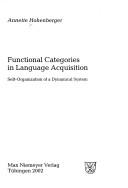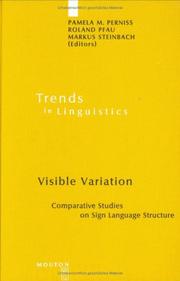| Listing 1 - 2 of 2 |
Sort by
|

ISBN: 3484304561 3110923521 9783110923520 9783484304567 Year: 2011 Volume: 456 Publisher: Tübingen
Abstract | Keywords | Export | Availability | Bookmark
 Loading...
Loading...Choose an application
- Reference Manager
- EndNote
- RefWorks (Direct export to RefWorks)
This study investigates the acquisition of Functional Categories (e.g., INFL (AGR, TNS), DET, COMP) from the perspective of self-organization in generative grammar. Language is conceived of as a dynamical system which evolves in time and bifurcates when critical thresholds are reached. The emergence of syntax as evidenced by the acquisition of Functional Categories is the major bifurcation in child language acquisition. Target values of syntactic parameters are attractors which children approach on individual trajectories. A proposed tripartite scenario of change - from a simple stable state A, via symmetry-breaking in a liminal phase B characterized by variation, to a new complex stable state C - accounts for the dynamics in early grammatical development. Traditional generative issues, such as the acquisition of case-marking, finiteness, V2, and wh-questions, are discussed as well as new issues, such as functional neologisms, and sentential blends. Dynamical notions like precursor, oscillation, symmetry-breaking, and trigger are important explanatory tools. The growing child phrase marker is a fractal mental object which represents syntactic information by way of self-similar extended projections. The book addresses researchers in language acquisition from various theoretical camps: generative, functional, connectionist, by giving new answers to old questions in the light of a novel challenging theory: self-organization.
Acquisition du langage --- Acquisition of language --- Auto-organisation (Théorie des systèmes) --- Fonctionalisme (Linguistique) --- Functionalism (Linguistics) --- Functionalisme (Taalwetenschap) --- Langage [Acquisition du ] --- Language acquisition --- Language development in children --- Learning systems (Automatic control) --- Self-optimizing systems --- Self-organizing systems --- Systèmes auto-optimalisants --- Systèmes auto-organisés --- Systèmes d'apprentissage (Commande automatique) --- Taalverwerving --- Zelfregelende systemen --- Language acquisition. --- Grammar, Comparative and general --- Language and languages --- Syntax --- Developmental linguistics --- Developmental psycholinguistics --- Psycholinguistics, Developmental --- Interpersonal communication in children --- Psycholinguistics --- Syntax. --- Acquisition --- Linguistics --- Philology --- Grammar, Comparative and general Syntax


ISBN: 9783110198850 3110198851 9783110195781 311019578X 1282194593 9781282194595 9786612194597 6612194596 Year: 2008 Volume: 188 Publisher: Berlin Boston
Abstract | Keywords | Export | Availability | Bookmark
 Loading...
Loading...Choose an application
- Reference Manager
- EndNote
- RefWorks (Direct export to RefWorks)
It has been argued that properties of the visual-gestural modality impose a homogenizing effect on sign languages, leading to less structural variation in sign language structure as compared to spoken language structure. However, until recently, research on sign languages was limited to a number of (Western) sign languages. Before we can truly answer the question of whether modality effects do indeed cause less structural variation, it is necessary to investigate the similarities and differences that exist between sign languages in more detail and, especially, to include in this investigation less studied sign languages. The current research climate is testimony to a surge of interest in the study of a geographically more diverse range of sign languages. The volume reflects that climate and brings together work by scholars engaging in comparative sign linguistics research. The 11 articles discuss data from many different signed and spoken languages and cover a wide range of topics from different areas of grammar including phonology (word pictures), morphology (pronouns, negation, and auxiliaries), syntax (word order, interrogative clauses, auxiliaries, negation, and referential shift) and pragmatics (modal meaning and referential shift). In addition to this, the contributions address psycholinguistic issues, aspects of language change, and issues concerning data collection in sign languages, thereby providing methodological guidelines for further research. Although some papers use a specific theoretical framework for analyzing the data, the volume clearly focuses on empirical and descriptive aspects of sign language variation.
Sign language. --- Language and languages --- Psycholinguistics. --- Linguistic change. --- Langage par signes --- Variation (Linguistique) --- Psycholinguistique --- Changement linguistique --- Variation. --- linguistic typology. --- Linguistic change --- Psycholinguistics --- Sign language --- Variation
| Listing 1 - 2 of 2 |
Sort by
|

 Search
Search Feedback
Feedback About UniCat
About UniCat  Help
Help News
News